
The cervical cap or contraceptive cap is a barrier method of birth control. It is a small silicone cup that is inserted into the vagina in order to prevent pregnancy. A suction mechanism allows the cap to sit over the cervix, blocking sperm from entering the uterus and preventing fertilization. For people with vaginas who desire an unobtrusive birth control method, the cervical cap is rarely felt by the penetrating partner and leaves much of the vagina accessible for direct, skin-to-skin stimulation.
However, the cervical cap does have some disadvantages, not least of which is it offers no protection against sexually transmitted infections (STIs). One may choose to use a male condom in addition to the cap to mitigate this risk. In addition, one must use a spermicide in conjunction with the cap in order to ensure its contraceptive function. Several brands of cervical cap used to be available until the early 21st century. Currently, the only available cervical cap in the U.S, Canada, and Europe is the FemCap, so this article will direct its focus to that specific brand.¹

Table of Contents
Efficacy
When deciding on a birth control method, the user’s primary concern is often efficacy. Like any other type of contraception, a cervical cap is most effective when used correctly and consistently. The perfect use rate for preventing pregnancy with a cervical cap is 91% for nulliparous females (those who have never given birth), and 74% for parous females (those who have). In typical use, the cervical cap is 86% and 71% effective for nulliparous and parous females, respectively.¹ Thus, it is a more optimal method of birth control for nulliparous females rather than parous ones. This discrepancy may result from long-term changes in the cervix’s size and shape following childbirth.² As the cervical cap works by creating a seal, it may be less effective when the cervix has been dilated.
How to Use the Cervical Cap
The cervical cap requires more practice to use than other forms of birth control, since it must form a complete seal over the cervix to be effective.
Insertion
The cervical cap can be inserted up to six hours before intercourse but will ideally be inserted at least fifteen minutes before.¹ Before insertion, it is best to empty your bladder. Wash your hands thoroughly with soap and water. As you prepare to insert it, you should ensure the cap is undamaged, and then apply a dose of spermicide. Follow the instructions of your doctor and/or the packaged instructions as you place it directly below your cervix. Read below for more detailed instructions:
- Prepare the cervical cap by filling it with about ¼ teaspoon of spermicide in the cup, plus a thin, additional layer on the part of the brim that’s flat.
- Flip it over. Put about one-half of a teaspoon of spermicidal jelly between the crease of the dome and the brim. Spread another thin layer on the brim of the cap.
- Find a comfortable position to insert the cap. You can stand with one foot on a chair, lie down, sit on the edge of a chair with knees parted, or squat.
- Using one hand, put your index and middle fingers into the vaginal canal to locate the cervix.
- Now that you know where to place the cap, separate the labia with one hand and squeeze the outer edge of the cap with the other hand. With the cervical cap’s dome facing down, push it far into the vagina with the long brim side entering first.
- Use a finger to position the cap over the cervix.
- Make sure that the cervix is completely covered by running a finger around the cap’s edge. Test the seal of the cap by gently tugging on it; there should be some suction and resistance.³
If the cervical cap is inserted correctly, you should not feel it during intercourse.

Removal
After each time you engage in intercourse, confirm that the cervical cap is still covering the cervix. It must be left in for at least six hours to perform its contraceptive function. You may leave it in for up to 48 hours in anticipation of further sexual activity, but you must put in a new dose of spermicide every time you have intercourse and ensure that it is still in the correct position.¹ Additional doses of spermicide can be directly put in your vagina using your finger. When you decide to remove your cervical cap, follow the steps below.
- Wash hands thoroughly with soap and water.
- While squatting down, use a finger to apply pressure on the dome and break the suction.
- Hook a finger under the removal strap to gently pull the cervical cap down and out of the vagina.³
Taking your cap out may not require as much finesse as inserting it. Once it’s removed, clean it thoroughly so that it lasts for the greatest amount of time possible.

Caring for Your Cervical Cap
If you take good care of your cervical cap, you should only need to replace it once per year. Thus, it is a less wasteful method of birth control than condoms or sponges! Cleaning a cervical cap is simple.
- After the cap has been removed, wash it with a small amount of mild soap and warm water.
- Allow the cap to air dry.
- If odors persist after use, soak the cap in a solution of lemon juice and water. Air-dry the cap after soaking. Repeat the process as necessary until any lingering smell is gone.
- Do not use any powders to clean the cap as this can cause infections.
- Store your cap away from intense heat or cold.³
Be sure to check the cap regularly to ensure it stays effective and in good condition. You can hold the cap up to a light or fill it with water to look for tears, small punctures, or other signs of deterioration. A cervical cap may still be used if it becomes discolored over long-term use, but if any holes or weak spots appear, talk to your physician about obtaining a replacement. In the meantime, use an alternative method of contraception or abstain from sex.³
To prevent wear, do not use oil-based lubricants while the cervical cap is in place. Oil-based lubricants can weaken or damage the silicone material. Switch them out for water-based lubricants, such as Astroglide and K-Y Jelly.²
Douching can irritate your vagina and lead to pelvic infections, so you ought to avoid it in general. However, if you use a cervical cap and choose to douche despite the risks, you should postpone douching for at least six hours following intercourse so the spermicide is effective.¹
Refitting
Giving birth, having an abortion or miscarriage, or getting pelvic surgery will often affect the cervical cap’s ability to create a seal around the cervix.³ If you have recently experienced any of these or are otherwise having trouble getting your cervical cap to fit correctly, see your doctor for a refitting.
Where Do I Get a Cervical Cap? How Much Does It Cost?
In order to obtain a cervical cap, visit your preferred health care provider, clinic, or health center. During your appointment, a health care professional will perform an examination and consider your health background to determine whether a cervical cap is an appropriate method of contraception. Your health care provider will assist you in locating the correct size cap, give you information for its proper use, and demonstrate the proper insertion and removal techniques. If you have been approved for a cervical cap in the United States, Europe, or Canada, a physician will give you a prescription for the FemCap.
The FemCap is available in three sizes:
- Small, for those who have never been pregnant
- Medium, for those who have previously had an abortion, miscarriage, or cesarean delivery
- Large, for those who have given birth vaginally³
Once obtaining a prescription for the correct size, you can get a cervical cap from a pharmacy, drugstore, or health center. The examination and cap together may be free (depending on your health insurance) or up to $275. Spermicide kits are around $5 to $15 each. Statewide health care programs or Medicaid may provide financial assistance when purchasing this form of contraception in the U.S. based on your income and legal status.³
The FemCap can also be ordered online with a prescription, and appointments to obtain a prescription can be scheduled through their website as well.
Advantages of Cervical Cap Use
Use of a cervical cap is often a safe, simple, and convenient way to prevent pregnancy. Women use this method of birth control because:
- It is small, comfortable, and easy to carry around in a small bag or pocket
- It is immediately effective upon insertion and can be removed at any time
- It usually cannot be felt by a partner³
- It has no effect on the natural hormones a woman produces
- The cap can be inserted many hours ahead of time, so as not to interrupt sexual activity
- It can be used during breastfeeding²
- It does not affect future fertility²
- It costs less than hormonal contraception²
- If this seems like your ideal method of contraception, you can reach out to a medical professional and let them know what you are thinking.
Disadvantages of Cervical Cap Use
Considering all of the benefits and risks when choosing a form of contraception is an important aspect of the decision making process. The possible disadvantages of the cervical cap include that it:
- Cannot be used during menstruation²
- May be difficult to insert and remove for some women
- May be dislodged in certain sexual positions or under heavy thrusting
- Must be in place every time a woman wishes to engage in vaginal intercourse²
- May need to be replaced with a larger diameter cap after an abortion, miscarriage, or pregnancy³
- Does not protect against sexually transmitted infections²
- Works best with a spermicide, most of which contain nonoxynol-9, a chemical that can increase your risk of human immunodeficiency virus (HIV)³
- Requires a prescription from a heath care provider
- Sometimes may cause odor problems if left inside the vagina for more than 24 hours²
If these sound like dealbreakers, the cervical cap may not be the right method of contraception for you. Some of these problems can be alleviated—for example, if you want to use a cervical cap and also have STI protection, the penetrating partner can wear a condom.
When You Shouldn’t Use A Cervical Cap
In some instances, use of a cervical cap could be irritating, unhealthy, or even dangerous. You may not want to use a cervical cap under the following conditions:
- If you have had an abnormal Pap test
- If you have been known or suspected to have uterine/cervical cancer
- Having a current infection in your vagina or cervix¹
- Having a silicone or spermicide allergy³
- If you have previously had pelvic inflammatory disease (PID), toxic shock syndrome, cervical cancer, third degree uterine prolapse, urinary tract infections (UTIs) or tears in the vaginal or cervical tissue⁴
- If you have had previous failure using barrier methods of contraception⁴
Birth control should be safe and not put the user in danger. Do not take the if you have any of these underlying issues.
Even if you have been using a cervical cap successfully, it is possible to develop new issues over time. Check with a health care professional if you experience the following:
- Vulval or vaginal soreness, itchiness, discoloration, or swelling
- Repeated bladder infections³
- The cap comes out of place during everyday activities
- Signs of toxic shock syndrome (emergency, must treat right away)
- Non-period blood is present on the cervical cap after removal⁴
- Unusual smell or color of vaginal discharge
- Otherwise, unexplained fever or chills
- Pain in the belly or pelvis
- Painful sex⁵
Again, be safe and take precautions. Do not let problems worsen until they become serious. Contact your doctor immediately if you notice anything unusual or concerning while using a cervical cap.
Concluding Remarks
While the selection of cervical caps is limited (depending on where you are in the world), it is an inexpensive, reusable barrier method of contraception that does not utilize hormones which alter one mentally and physically. It takes time to learn how to use properly, but it is fairly effective when used correctly and with spermicide. It may not be the method for you if you want STI protection, have a history of pregnancy, or have a history of reproductive system infections or toxic shock syndrome. However, if you can safely utilize the cervical cap, then you can enjoy intimate vaginal intercourse without hormonal birth control.
References
- (2020, September 28). Cervical Cap. Center for Young Women’s Health. https://youngwomenshealth.org/2011/06/01/cervical-cap/
- Healthwise Staff. (2020, October 8). Cervical Cap for Birth Control. C.S. Mott Children’s Hospital. https://www.mottchildren.org/health-library/tw9511#tw9511-sec
- Cervical Cap. Planned Parenthood. https://www.plannedparenthood.org/learn/birth-control/cervical-cap
- (2020, February 26). Cervical Cap. Mayo Clinic. https://www.mayoclinic.org/tests-procedures/cervical-cap/about/pac-20393416
- Hirsch, L. (2018, May). About the Cervical Cap. KidsHealth from Nemours. https://kidshealth.org/en/parents/cervical-cap.html
Last Updated: 27 May 2021
